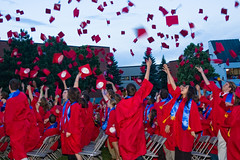Strobist Style with a Nikon D70s
Before I start in earnest to work on Lighting 102 at Strobist I thought it would be a wise idea to review the various flash settings of the Nikon D70s for off-camera flash. Essentially, there are two ways off-camera flash can be controlled by the D70. Either wirelessly or tethered with PC cables and the like. Since one of the two flashes I have does not sport a PC connection nor do I want to spend extra time or cash to accommodate a PC connection, we'll talk only about wireless.
What is Custom Setting 19?
This is the heart of the matter. You won't even see it unless you go to the Setup Menu (little icon that looks like a wrench) and select option 4 (CSM menu). There are two choices: Simple and Detailed. Select Detailed. This will give the Custom Settings menu (little icon that looks like a pencil) 16 additional settings to control. Oh boy! More stuff! It's like Christmas!In the Custom Settings menu, option 19 Flash Mode, you have three choices ... TTL (Through The Lens) surrendering control to the camera and its exposure meter; Manual which sets the output level for the built-in speed light; and Commander Mode ... here's the sap in the tree! Commander Mode allows you to use the D70s' built-in speedlight to trigger remote flash units like the SB800 and/or the SB600. It is here we want to look further.
Commander Mode also has its own three options ... TTL: again surrendering control to the camera and its exposure meter; AA: (Auto Aperture, available only when CPU lens is used with SB-800), forget about it for right now ... that setting is still surrendering part of the exposure control to the camera; and M: (Manual Mode ... ooohh, aahhh) that's what I'm talkin' 'bout! Manual mode allows you to set the output level of your wireless, off-camera flashes from full power to 1/128th power. This is where we'll be working.
Now ... it's important to note that in wireless communication, perhaps we're talking about your laptop to a wireless router or your cordless phone, there are "channels" of communication. Literally, you set your device to a particular channel to communicate with another device or perhaps this one or both devices do this automatically. The Nikon D70s has no choices. It is permanently committed to communicate on Channel 3 ... whatever that means. You can't change it. There's no Custom Setting 26 or Commander Mode/Manual/Channel setting.
Let's move on ...
We should now have custom setting 19 Flash Mode set to Commander with Commander menu set to M (Manual) ... at this point you can choose any power output level say ... 1/16th power.Now ... let's look at adding a flash unit to the mix. Keeping this simple for the time being, we'll look at an SB600. On the flash unit hold down the Zoom and the minus(-) sign together for 3 seconds or so to enter the Custom Settings menu for the flash unit. Press Mode until the the wireless symbol appears and press either the plus (+) or the minus (-) sign until the unit says "On." Hold down the Zoom and minus buttons together for 3 seconds or so to exit the Custom Settings menu.
Next press Mode to highlight the Channel setting on the flash and then +/- until it reads Channel 3 ... press Mode to highlight the Group setting and then +/- until it reads Group A. Raise the camera's built-in speedlight and test fire the camera. It should now trigger the flash even though the flash is not connected to the camera. In fact, it triggers the flash with an output level equivalent to the output setting you set on the camera ... Commander Mode/Manual/1/16th power.
Now, when you are setting up your shots for Strobist Lighting102 you can start with ...
- Set your shutter speed to 1/125th (or your choice of the other appropriate sync settings)
- Take a reading of ambient light (with the camera meter, of course)
- Set the aperture to underexpose 2 stops less than the ambient light reading
- Take a test shot (camera telling the flash to fire at 1/16th power)
- Adjust flash output using Commander Mode/Manual/power level until the exposure is correct
We'll keep it simple for now. For future posts we'll cover the setup for using two flash units with the D70s and then another post for using two flash units and controlling their output independently of the camera.
i shoot nikon






